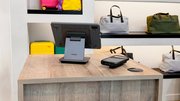Article
Eyes in the sky
Surveillance kiosks can enhance the amusement park experience. But some manufacturers see fun and safety, not park security, as the ultimate goal.
February 18, 2002
An amusement park, by its very nature, encourages exploration. There are colorful sights in every direction, rides and attractions that beckon both children and adults to look, listen, and ride.
It is fun, of course, but it is also a headache for the attentive parent. Kids love to have the run of a park, but parents need to monitor the child's well being.
Enter the kiosk.
Two companies are developing products that not only offer safety features for parents, but strive to make the entire park visit more enjoyable.
Watching your every move
Laguna Hills, Calif.-based firm SafeTzone Technologies offers a kiosk-based program called the SafeTzone System. It is an integrated package of mapping kiosks and tracking bracelets, working through a wireless network backbone.
Patrons that use the service are given coded bracelets to wear upon entering the park. If someone gets separated from their party, they can go to one of the SafeTzone kiosks and scan their bracelet to see visually where the rest of their group is. The park charges the patrons a fee to use the service, either in the form of daily rental or a season pass.
The system is currently in use at one amusement park, Wild Rivers Waterpark in Irvine, Calif.
"When parents of children or guests within a group become lost or separated, our system allows them to identify the location of their group members on an electronic map of the park," said Regan Kelly, SafeTzone executive vice president.
The map is displayed on a kiosk's touchscreen. Kelly said that Wild Rivers currently has three of the kiosks in place; a fourth will be deployed this year. The three kiosks were deployed in August, just a month before the park closes for the fall, so Kelly said he did not have significant data on usage.
Kiosk placement within the park is key, according to Kelly.
"They're almost visible from one another," he said. "We try to make the kiosks available so that wherever you are in the park, you can look to the left or the right and see one of them."
System costs depend on the size of the amusement park. For a 20-acre facility, he estimates that an installation would cost a park about $250,000 (Wild Rivers is about 20 acres, but Kelly did not disclose how much the park paid for the system). If the environment already has a good wireless network in place, the price can go down. Parks do not purchase the system, but pay a license for the system and equipment. SafeTzone provides system maintenance.
 |
Amusement park patrons can track their group's whereabouts on SafeTzone's kiosk. |
"(The park) can either pay the license fee up front, or we can be flexible with how we set up the revenue structure over a term of years," Kelly said.
The enclosure, manufactured by Envirosealed of Hixson, Tenn., contains an ultra-bright touchscreen monitor and a CPU running Windows NT. Kelly said the system has additional options that were not installed at Wild Rivers, such as a message board where guests can leave memos for other members of their group and pop-up alerts.
Take a picture
Utilizing a similar technology, Newton, Mass.-based MetaSignal Inc. has a slightly different approach. Their product not only allows park patrons to be monitored at all times, but it also videotapes their every move.
"A guest would get a credit-card sized tag, and they can move about the park and do what they normally would do," company co-founder Rakeim Hadley said. "The tags link back to cameras that are placed around the park, and our system can automatically pull together all footage that's been gathered of that person. Then they could go up to a kiosk and see the last couple of clips that have been taken - a parent can check up on a child, see where they were located at that time."
While this technology sounds intrusive, Hadley said there is one fun component of all that taping. At the end of the day, the family can go to a kiosk to place an order for a CD-ROM or DVD, which contains mpeg-2 video of all the day's exploits.
MetaSignal is still in the start-up phase, and has not yet installed their system in any parks. Hadley said that costs will vary, but estimates that one version of the system, which would provide camera coverage for one ride, would cost about $40,000.
"We expect by fall of this year to be installed in a park," he said.
Future uses?
The SafeTzone system in use at Wild Rivers is not too far removed technologically from biometrics systems, such as airport check-in kiosks that feature facial recognition or iris-scanning software.
But Kelly believes that the product will probably not evolve as a security measure. Parks that license the system can use it however they choose, but he does not foresee the wearing of tracking bracelets as a requirement for entering a park.
"I just can't see it being mandatory," he said. "I think it would raise too many issues where people would object - people would not want to be tracked throughout the park. We don't want to get into that area. We want to provide a tool for guests who choose to use the system."
Hadley, on the other hand, sees potential in using MetaSignal products as a security deterrence. He said that MetaSignal's existing system can be modified easily to become a more security-intensive product.
For instance, alerts can be set up if parent and child get too far apart. Certain ID tags can restrict patron access in certain areas of the park, triggering an alert if the visitor ventures into the forbidden area.
MetaSignal, according to Hadley, is working on a next-generation use of the technology with a pure security function. This technology would not require ID cards, and the people being watched would not know that they were under scrutiny. It would be better suited to more serious environments - such as large warehouses or anywhere groups of employees need to be monitored.
"It could use video and metrics to track people and identify them in a closed environment. Definitely, since 9-11 there's been more willingness to think about other applications," he said.
"I don't see it as being a theme-park application," Hadley added.










